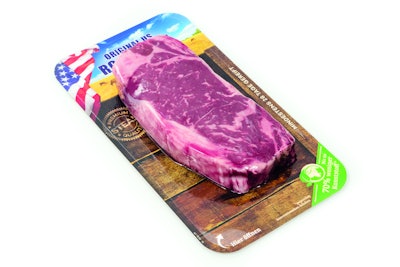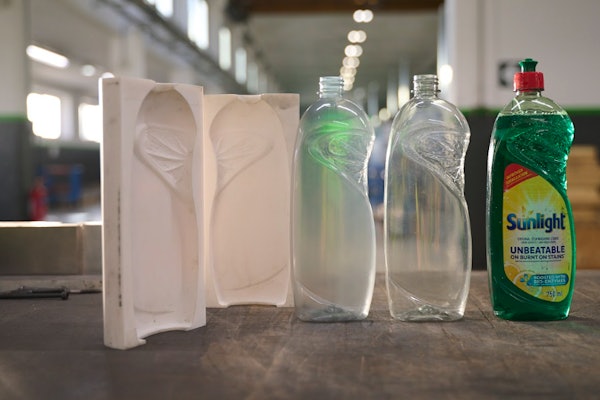
How can meat products be packaged sustainably without having to compromise on product protection, hygiene, and convenience? This is where suppliers to the packaging industry, food manufacturers, and retailers are searching for new solutions.
Until today, there have been few suitable alternatives to plastic when it comes to packaging fresh red meat. But now OSI Europe, which supplies meat products to leading brands in foodservice and retail, has opted for FlatSkin®, an innovative packaging method that scores some significant sustainability points by reducing the amount of plastic involved. OSI is a subsidiary of Aurora, IL-based OSI Group, which operates more than 65 production sites andhas 20,000 employees in 17 countries.
FlatSkin is a joint development of three packaging technology specialists: SEALPAC, supplier of high-tech tray-sealing technology; VG Nicolaus GmbH, specialist in paperboard packaging and folding cartons; and Wentus Kunststoff GmbH, professionals in the field of barrier films and laminations. By joining hands, these three companies were able to develop a vacuum skin-packaging format that fulfills the demands expressed by OSI.
A major trigger for OSI to switch to this new packaging system is an ongoing change in market conditions. As Erik Schöttl, Managing Director Foodworks Europe at OSI, explains: “We recently see a trend towards high-quality products, such as our dry-aged steaks. These products need to be packaged with both shelf appeal and product protection as key considerations. At the same time, sustainability has grown increasingly important in the decision-making process of the consumer. Therefore, we started looking for a high-end packaging solution for our premium beef steaks that would not only combine maximum product safety and high-class graphics, but would also offer convenient handling, cost-efficiency, and conservation of resources.”
In the FlatSkin® process, the Sealpack machine used is the A7 traysealer. Four packs per cycle are produced at a rate of about seven cycles/min. A highly transparent roll-fed barrier film called WENTOPRO SkinTight 15 FS from Wentus Kunststoff pins the product, for example a steak, directly onto an extremely flat paperboard carrier. This film, a 7-layer coextrusion that includes EVOH for oxygen barrier, is applied under vacuum.
Worth noting is the composition of the paperboard carrier, which is made from bleached or unbleached fiber. VG Nicolaus receives from Wentus a seven-layer coextrusion that it adhesive laminates to the paperboard after it’s been printed. This serves as a protective layer that provides stability to the paperboard and forms a reliable barrier against grease, moisture, and oxygen. Another important performance characteristic in this material is that it is specially formulated so that consumers have an easy-peel experience when they go to remove the vacuum skin-packaging film that holds the steak to the paperboard.
The paperboard carrier can be printed on both sides, hence offering optimal space for product information while providing unique branding opportunities. In the case of OSI, the printing is done front and back on an offset press in four colors.
The FlatSkin® system combines all the benefits of vacuum skin packaging, such as extended shelf life and natural aging of the beef, with a particularly attractive product presentation. At the same time, the system is extremely economical and sustainable, as it significantly reduces the amount of plastic used and improves recyclability.
“With this packaging solution, compared to common plastic skin trays, a plastic reduction of up to 75% can be achieved,” says Burkhard Meyer, Sales Director at Wentus. “The top film, which fixes the product onto the laminated paperboard carrier, has a thickness of just 125 microns.”
Marcel Veenstra, Marketing & Communications Manager at SEALPAC, adds: “The trick to FlatSkin®is that once the consumer has removed the steak from the package, the seven-layer coextrusion from Wentus that VG Nicolaus laminates to the paperboard is easily removed from the paperboard by means of a peel tab. This allows for separate disposal of the paperboard carrier in thepaperboard recycle stream, while both liner and skin film can treated as plastic waste.”
Included in the printed graphics on both front and back are references to the pack’s sustainability. On the front bottom right corner is this: “70% less plastic.” And on the top right corner on the back of the pack is a peel tab with a “Recycling Tipp” advising consumers to pull at this corner to peel off the coextruded protective layer so that it can be disposed of separately from the paperboard, which of course goes into the ordinary paperboard recycle stream.
The three participating companies put a great deal of effort into the FlatSkin® project. Challenges included the climatic conditions prevailing in the meat industry, such as the high levels of humidity in production and logistics. "If fibrous materials like paperboard absorb moisture, the fibers start to expand, which can cause the carrier to bend,” explains Manfred Grupp, Sales Manager at VG Nicolaus. “This is why the carriers need to have excellent flatness. For this reason, we performed numerous tests under cold and humid circumstances in our own laboratory and in SEALPAC’s Experience Centre in Oldenburg, Germany, to ensure a smooth packaging process and excellent optics at all times." Also critical was identifying the best possible heat seal material that would provide a reliable seal of vacuum skin packaging film to the laminated paperboard while also providing easy peeling in the hands of the consumer. The large and prominently marked peel tab contributes to ease of opening of the skin pack.
The result is convincing. FlatSkin® not only ensures savings in plastic. The excellent two-sided printability of the paperboard carrier, which offers sufficient room for branding and product information, makes the addition of a paperboard sleeve, that is often required forvacuum-skinned products, unnecessary.
With the new packaging system, more packs fit into the reusable crates that serve as secondary packaging. “This in turn reduces the amount of trucks on the road,” says Markus Holler, Group Operations Director Europe at OSI. “Furthermore, not only do we use less material for packaging, but by separating and disposing of the components separately, we support better recycling.”
FlatSkin® is used for the premium products within OSI’s product portfolio. Says Robert Zeller, Sales Director Meat Solutions at OSI, “Most important, our customers receive the highest quality. Meat products, such as our steaks, mature very well in the packaging. After opening, the meat keeps its appetizing color and convinces with an extremely tender structure.”
When asked about the relative cost of FlatSkin, Sealpac’s Veenstra says that the paperboard itself is about 30% more expensive than the plastic tray commonly used for years in vacuum skin packaging of fresh red meat. “But its excellent printability saves costs by eliminating the paperboard sleeve and labels typically required in the plastic tray approach. As such, the overall FlatSkin pack should be around 20% less costly. And on top of that are all the additional advantages in logistics, warehousing, food waste, and plastics usage,” says Veenstra.
OSI Europe is proud of having implemented this new packaging concept so quickly and for bringing it to the market first. Since the spring of 2018, the company has been successfully supplying all NETTO Marken-Discount stores in Germany with beef steaks packaged in FlatSkin. The positive feedback from the retailers underlines the success of FlatSkin®. Management at OSI Europe is particularly pleased about the fact that, despite a completely new packaging process, they received no complaints after many thousands of delivered packs. The company can be regarded as a pioneer for bringing more sustainability to the self-service meat segment, hence creating a strong buzz in the market. Now OSI will gradually extend the use ofFlatSkin®to other countries.
How will this development continue? All the partners involved in the FlatSkin® project agree that efforts should be made towards an even more efficient use of resources. OSI will continue to focus on more sustainability through better recyclability and further reduction of consumables. “We are investigating the extent to which the thickness of our packaging can be reduced while maintaining the same level of protection for our products,” says OSI’s Holler.
In addition, film manufacturer Wentus is working on further reducing film thicknesses. Also being explored are recyclable monomaterials such as PP-based film. Wentus’s Meyer points out, however, that any monomaterial proposed for this package would have to be equally effective at providing the kind of barrier properties that the current materials do.
"For fresh food products--due to the required water vapor barrier, oxygen barrier, and hermetic seal--there is no real alternative to plastic,” adds Sealpac’s Veenstra. “That’s why it’s important for us to think about sustainability in different ways." Grupp of VG Nicolaus concludes: "With FlatSkin® we have impressively shown that it is indeed possible to replace parts of the plastic packaging with alternative materials such as fiber."



















